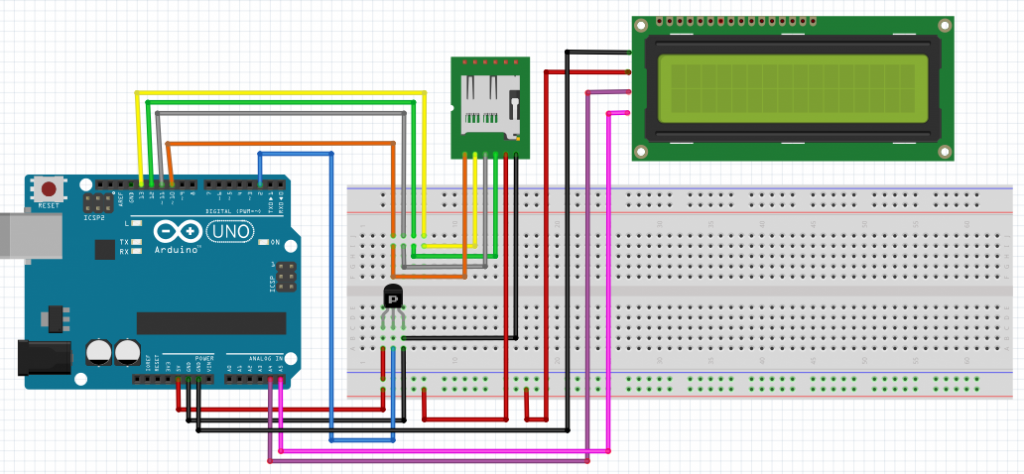
In our daily research, we often have to fight with some practical limits. Of course, I’m not referring to the impossible overpassing of the thermodynamic principles. I’m thinking about elementary hands-on problems. For example, I’ve been working on zeolites since last years. The synthesis of zeolite involves a series of steps were the regulation of the temperature is of great importance and any temperature fluctuation should be avoided.1, 2 Despite we have many instruments for controlling the temperature for several hours (e.g. a standard hotplate stirrer), it’s sometimes difficult to find a device which can record data. Especially if we are looking for a cheap, smart and dynamic device.
These circumstances gave me the occasion to exploit the potential of Arduino and build up a simple temperature recorder device. Arduino is “an open-source electronics platform based on easy-to-use hardware and software” (https://www.arduino.cc/) which can be used to design an infinite numbers of devices with different properties in a very dynamic way (e.g. I’m planning to build a pH-meter with 40€ budget). Furthermore, as described in an article appeared last year in Nature, Arduino (and other similar such as Raspberry Pi) it’s attaching a lot of interest also in the scientific community.3
Herein, I describe the building instruction of a temperature recorder device. (If you don’t have any experience with Arduino I suggest you watching some tutorials online)
In this first part of the blog, I’ll describe how to assemble the device, while in the next blog I will focus on writing the code of the new Arduino device.
First of all, we need to collect all the materials:
- Arduino platform: as it’s an open source device, the internet is full of Arduino cheap solutions. For example, you can buy the original Arduino for 25€, or legal reproductions for 3-4€.
- Micro SD reader: internet offers many Arduino Micro SD card reader. However, it does not matter which one you prefer, they all function well. You can easily find it for less than 1€.
- Micro SD: you can valorise your old outdated 254 MB micro SD, or use any micro SD (g. 3000 data points correspond to less than 70 KB)
- Thermometer sensor: there are several thermometer sensor on the market. Choose the most suitable to your aims. In my case, I’ve selected a DS18B20 waterproof sensor already equipped with a 4.7 kΩ pull-up resistor. You can find it for 2-3€. Alternatively you can mount the resistor as follow:

- LDC screen: I recommend buying the 1602 I2C LCD module, which has only 4 outputs, instead of the 16 outputs of the standard LCD one. It costs around 3€.
- Cables: you can buy the M-M Arduino cables or reuse standard electric cables (but in this case you will have to solder).
- Tie-Points Breadboard: you can choose the one you prefer (standard one has 400 tie-points). They cost around 3€.
To build up the device, we can follow the scheme below:

More in details we have to connect the components as follow:
- Temperature sensor: VCC to 5V in the Arduino; Sensor cable to 2; GRD to GRD. In case of DS18B20, remember to place the 4.7 kΩ pull-up resistor.
- SD reader: VCC to 5V in the Arduino; GND the GND; CS to pin 10; SCK to pin 13; MOSI to pin 11; MISO to pin 12.
- 1602 I2C LCD module: VCC to 5V in the Arduino; GND the GND; SDA to pin A4; SCL to pin A5.
At this point, we need to find a way to power up our device! There are three possibilities:
- USB cable
- Batteries
- Wall warts
I prefer to use the USB cable connected with mobile recharger jack (but it’s important to check the voltage if we don’t want to burn our circuit!).
As far as now, our device is ready for the lab…..but still we have to write the code for the board! Wait for the next part of the blog!
Alessio Zuliani, University of Cordoba
- Benamor, T.; Vidal, L.; Lebeau, B.; Marichal, C., Influence of synthesis parameters on the physico-chemical characteristics of SBA-15 type ordered mesoporous silica. Microporous and Mesoporous Materials 2012, 153, 100-114.
- Qian, X. F.; Du, J. M.; Li, B.; Si, M.; Yang, Y. S.; Hu, Y. Y.; Niu, G. X.; Zhang, Y. H.; Xu, H. L.; Tu, B.; Tang, Y.; Zhao, D. Y., Controllable fabrication of uniform core-shell structured zeolite@SBA-15 composites. Chemical Science 2011, 2 (10), 2006-2016.
- Cressey, D., AGE OF THE ARDUINO. Nature 2017, 544 (7648), 125-126.




